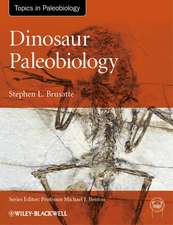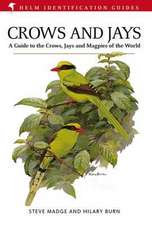Communication Within Animal Cells
Autor Greg J. Barritten Limba Engleză Paperback – 8 apr 1992
Preț: 590.84 lei
Preț vechi: 729.42 lei
-19% Nou
Puncte Express: 886
Preț estimativ în valută:
113.07€ • 122.78$ • 94.98£
113.07€ • 122.78$ • 94.98£
Carte tipărită la comandă
Livrare economică 22 aprilie-06 mai
Preluare comenzi: 021 569.72.76
Specificații
ISBN-13: 9780198547266
ISBN-10: 0198547269
Pagini: 360
Ilustrații: halftones, numerous line drawings, tables
Dimensiuni: 187 x 244 x 23 mm
Greutate: 0.79 kg
Editura: OUP OXFORD
Colecția OUP Oxford
Locul publicării:Oxford, United Kingdom
ISBN-10: 0198547269
Pagini: 360
Ilustrații: halftones, numerous line drawings, tables
Dimensiuni: 187 x 244 x 23 mm
Greutate: 0.79 kg
Editura: OUP OXFORD
Colecția OUP Oxford
Locul publicării:Oxford, United Kingdom
Cuprins
Networks of extracellular and intracellular signals; Role of cell structure in intracellular communication; The plasma-membrane receptors and GTP-binding proteins; The protein kinases and phosphatases; The cyclic nucleotides; The inositol polyphosphates and diacylglycerols; Calcium; The intermediary metabolites; Metabolites of arachidonic acid; Sequence-specific DNA-binding proteins; The oncogenes; Interactions between pathways of intracellular communication; Index
Recenzii
`This is a first edition of a remarkable book.'`This is an excellent book, well written and illustrated with key references throughout the text. This book will be read by preclinical dental and medical students and no dental school library should be without one.' European Journal of Orthodontics
'a long-awaited textbook of signal transduction ... The wait has been worth it - the book is excellent. I recommend this book enthusiastically to any student, practitioner, teacher or observer of the subject of signal transduction. It is not only an ideal teaching text, but also a valuable research resource as well. Dr Barritt has a refreshing modesty about his intentions in writing this book, but I would go so far as to predict that Communication within Animal Cells will become a core textbook, perhaps even a classic, in the field.'Michael R. Hanley, UCD School of Medicine, Davis, Ca., Trends in Cell Biology, Vol. 2 November 1992
'The high quality of this text owes much to the excellent standard of its illustrations, and overall it successfully covers a wide and rapidly developing topic at the requisite level for its target audience of advanced undergraduate and graduate students.'R.P. Newton, FEBS Letters, September 1992
'An extremely readable monograph for senior undergraduates and the like which provides an excellent introduction to the highly complex and fast-moving field of intracellular communication.'Aslib Book Guide, Vol. 57, No. 10, October 1992
'Written in a clear and authoritative style, with many illustrations, it will be invaluable to students on advanced undergraduate and graduate courses. It also provides a detailed introduction to a review of this central topic for researchers in cell biology and related disciplines.'Anticancer Research 12: (1992)
'Those who have had the good fortune to be taught by Professor Barritt as undergraduates well remember the wonderful clarity of his lectures, the flow of the ideas he presented and the delight of his lecture notes ... his book on "Communication Within Anmimal Cells" is a delight to read, not only for its scientific content but also for its flawless presentation. Such is the style of the presentation ... that the reader finishes it feeling that he has gained enormously in scientific concepts at the cost of an embarassingly small effort. Cleanly flowing text coupled with an abundance of uncluttered line drawings allow the ideas to form effortlessly in the reader's understanding ... wide ranging text ... a book which deserves to be widely read.'Richard G. Ryall, Women's and Children's Hospital, Adelaide, The Clinical Biochemist Newsletter, March 1993
'a long-awaited textbook of signal transduction ... The wait has been worth it - the book is excellent. I recommend this book enthusiastically to any student, practitioner, teacher or observer of the subject of signal transduction. It is not only an ideal teaching text, but also a valuable research resource as well. Dr Barritt has a refreshing modesty about his intentions in writing this book, but I would go so far as to predict that Communication within Animal Cells will become a core textbook, perhaps even a classic, in the field.'Michael R. Hanley, UCD School of Medicine, Davis, Ca., Trends in Cell Biology, Vol. 2 November 1992
'The high quality of this text owes much to the excellent standard of its illustrations, and overall it successfully covers a wide and rapidly developing topic at the requisite level for its target audience of advanced undergraduate and graduate students.'R.P. Newton, FEBS Letters, September 1992
'An extremely readable monograph for senior undergraduates and the like which provides an excellent introduction to the highly complex and fast-moving field of intracellular communication.'Aslib Book Guide, Vol. 57, No. 10, October 1992
'Written in a clear and authoritative style, with many illustrations, it will be invaluable to students on advanced undergraduate and graduate courses. It also provides a detailed introduction to a review of this central topic for researchers in cell biology and related disciplines.'Anticancer Research 12: (1992)
'Those who have had the good fortune to be taught by Professor Barritt as undergraduates well remember the wonderful clarity of his lectures, the flow of the ideas he presented and the delight of his lecture notes ... his book on "Communication Within Anmimal Cells" is a delight to read, not only for its scientific content but also for its flawless presentation. Such is the style of the presentation ... that the reader finishes it feeling that he has gained enormously in scientific concepts at the cost of an embarassingly small effort. Cleanly flowing text coupled with an abundance of uncluttered line drawings allow the ideas to form effortlessly in the reader's understanding ... wide ranging text ... a book which deserves to be widely read.'Richard G. Ryall, Women's and Children's Hospital, Adelaide, The Clinical Biochemist Newsletter, March 1993








